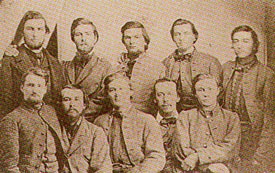Confederate POWs Marched Out Singing “Dixie”

Captain Tom Quirk and nine Morgan scouts.
Official records of POW deaths during the Civil War on both sides indicated that about 49,000 Union and Confederate soldiers died in 150 Prisoner of War camps. The major statistics are broken down in last week’s article, Union and Confederate POW camps in the Civil War.
Author Lonnie R Speer, however, in his 1997 book, Portals to Hell: Military Prisons of the Civil War; covering statistics from 96 Union and 117 Confederate facilities which housed POWs during the war, found 30,218 Confederate deaths and 25,796 Union deaths, bringing the total to just over 56,000. According to Speer, 15.5 percent of the Confederates prisoners died, a ratio 29 percent higher than the slightly more than 12 percent of Union prisoners that died. Speer’s statistics may even be conservative. Speer has only the 4,454 official deaths for Camp Douglas, but historical on-site estimates from Confederate prisoners in the last days of Camp Douglas and modern counts indicate there are at least 5,600 Confederate graves at or near Camp Douglas. In addition, about 400 bodies of Confederate soldiers were recorded as shipped to their families at home. George Levy in his 1999 book, To Die in Chicago; Confederate Prisoners at Camp Douglas 1862-1865, has a whole chapter, “Lost in Chicago,” on the missing Confederate dead.
More than 26,000 confederate POWs went through Camp Douglas, but many were paroled or exchanged before the war’s end. Also, there were many transfers from prison to prison for logistical and security purposes. All this, and the difficulties of keeping records during the tragedies, high tension, and fog of war make statistical analysis difficult and sometimes speculative.
The estimates for the number of POWs held during the war also differ. Early in the war, many POWs were immediately “paroled” and these would not be included in prison statistics. Speer cites 674,000 prisoners taken but only 410,000 spending a few days to a few years in a prison camp. There was a Confederate-Union prisoner exchange procedure instituted in July 1862 that emptied many POW camps, including Camp Douglas, but the agreement broke down by July 1863. Prisoner exchange would have saved thousands of Union POW lives, especially at Andersonville, because the Confederate forces and Southern civilian population were themselves hard pressed for food and medical supplies in 1864 and 1865. Sustaining Union POWs was becoming a burden best relinquished to better-supplied Union forces. The exchange process was essentially cancelled by July 1863 by President Lincoln and Secretary of War Edwin Stanton ostensibly over the issue of former slaves serving in the Union Army. In reality, it was about Stanton’s strategy of attrition to reduce Confederate forces:
“We do not propose to reinforce the rebel army by exchanging prisoners.” (August 1, 1864)
Stanton’s attrition strategy was devastating to Union POWs at Andersonville. The Confederates even tried to release Andersonville prisoners to Union forces with no return of Confederate prisoners, but they were refused. Likewise, Stanton would not release medical supplies to Andersonville POWs, because they might be used by Confederates.
By August 1863, Camp Douglas was rapidly filling to more than 12,000 prisoners. Its peak at the end of the war was 12,082. Starting on August 17, 1863, this included as many as 2,100 prisoners from John Hunt Morgan’s Kentucky Cavalry Raider force of nearly 2,500 that had been captured trying to cross the Ohio River into West Virginia after their daring and panic-creating raid into Indiana and Ohio in July 11-26, 1863. They had been caught between superior numbers of Union cavalry and infantry and Union gunboats in the Ohio river on July 19, and by July 26, most had been captured. On August 18, Union Colonel Charles V. DeLand was ordered to take charge of Camp Douglas. DeLand was plagued by escapes, mostly engineered by Morgan POWs, who maintained internal self-discipline through regimental sergeant-majors.
The first six of Camp Douglas’s eight Union commanders struggled with administrative and logistical problems but were not remarkable for a punitive or revengeful spirit. This was to change by orders of Secretary of War Stanton in July 1863. Food and heating rations were reduced as a matter of revenge for alleged Union POW suffering. Even vegetables were removed from the POW diet, causing scurvy. DeLand also introduced torture for interrogation or disciplinary infractions. This included hanging men by their thumbs for hours, which resulted in several deaths. He also introduced a torture called “riding the horse” or “riding Morgan’s mule,” where prisoners were forced to sit for many hours on the narrow and sharpened edge of a horizontal two by four and suspended by supports at least four feet off the ground. Guards often hung weighty buckets of dirt and rock on their feet to increase the pain. This often caused permanent disabilities. In May 64, Colonel Benjamin Sweet took command, and vengeful cruelties continued. Food rations were reduced even more. Moreover, charity and help from Chicago churches, civilians, and humanitarians were forbidden by Washington.
Of the Camp Douglas POW deaths officially recorded from February 1862 to June 1865, the following causes were recorded.
Fevers, smallpox, and malaria: 1,407
Pneumonia and pleurisy: 1,296
Diarrhea and dysentery: 698
Tuberculosis (Consumption): 113
Wounds and injuries: 80
Scurvy: 39
Rheumatism: 37
Bronchitis: 27
Other diseases and causes: 312.
These only total 4,009.
Many Confederate POWs that survived the war and captivity had their lives cut short by the ordeal. Sidney Lanier, of the 4th Georgia Regiment, probably Georgia’s most famous poet after the war, died at the age of 39 from Tuberculosis contracted at Point Lookout prison in Maryland.
The Camp Douglas 64 barracks were 90x20 feet with 70 feet of room space and 20 feet for a kitchen. There was a 20-footwide street between barracks. Only six barracks had a stove, and even those were removed in late 1863 by orders from Washington. A typical barracks room held 12 men, but not necessarily 12 beds or 12 blankets. The barracks were designed for about 96 men but were eventually crammed with 190. There was a hospital with two 100x28-foot wings. There was also a 75x30-foot church, allegedly owned by the YMCA. Religious tracts were abundant due to the Chicago Bible Society and Camp Chaplain Edwin B. Tuttle, an Episcopal minister. They also had easy access to sermons by visiting priests and ministers. Some men organized their own churches. Besides the many administrative, storage, and garrison buildings and services, there were 9 water hydrants, a dispensary, a post office, and even a tool shop.
The POWs had to be in their beds by sundown and could not leave the barracks before sunrise and a bugle call. They were forbidden to talk at night. Guards hearing talking in a barracks, would fire a warning shot into it, which was sometimes injurious or deadly. Otherwise, they had pretty much free-run of the camp. Amazingly, prisoners were allowed to keep small knives, saws, matches, and other tools, but they were frequently robbed by guards looking for money or other valuables. There was an internal system of law and order maintained by Confederate regimental sergeant-majors. Life could be almost normal except for restricted diets and punishments.
Prisoners were continually hungry but avoided starvation by dining on the numerous rats attracted to the camp. Their main resentment was continuous hunger and the cruelties of the last two Camp Douglas administrations and its increasingly cruel direction by Washington.
Reverend Tuttle remarked that the conditions at Camp Douglas brought out shocking weaknesses in some men and strong virtue in others. The selfish principle emerged in many, but others forged their character and strength at Camp Douglas. Many created friendships that lasted until they “answered to the long roll.”
Survivor T.M. Page suggested that “No body of men was ever more tried in any ordeal which tests human nature and proves it creditable to mankind.”
T.D. Henry wrote of his experience: “Think of a man’s mind being racked by all these punishments, for the innocent suffered as well as the guilty, and as frequently, when no one was to blame, were all punished; and it is almost a miracle that anyone could have remained there twenty months without losing their reason.”
R.T. Boone later remarked: “I wondered what caused all of this fearful mortality. Before me I saw the headstones of five thousand six hundred Confederates whose lives went out in prison.
Was it starvation, neglect, and cruelty? God only knows.”
E. D. Blakemore claimed that he did not have a square meal for 21 months, but reflected that it was war times, and we will have to forget its hardships and its brutalities. He only hoped that his old comrades would remember him kindly.
The Civil War ended in April 1865, but Camp Douglas did not release its prisoners until July 5, 1865. Confederate prisoners were offered transportation home by train, if they signed the Union Loyalty Oath. Otherwise, they would have to walk home. Most of the 12,000, who were able to walk, elected to walk home.
According to Curtis R. Burke, (Civil War Journal, published in 1914), a scout in Morgan’s elite independent scout company (Quirk’s Scouts),
“As we marched out of the gate into the open country, the boys had to give vent to their feeling, by giving three ringing cheers, singing Dixie.”









 Mike Scruggs is the author of two books: The Un-Civil War: Shattering the Historical Myths; and Lessons from the Vietnam War: Truths the Media Never Told You, and over 600 articles on military history, national security, intelligent design, genealogical genetics, immigration, current political affairs, Islam, and the Middle East.
Mike Scruggs is the author of two books: The Un-Civil War: Shattering the Historical Myths; and Lessons from the Vietnam War: Truths the Media Never Told You, and over 600 articles on military history, national security, intelligent design, genealogical genetics, immigration, current political affairs, Islam, and the Middle East. 


